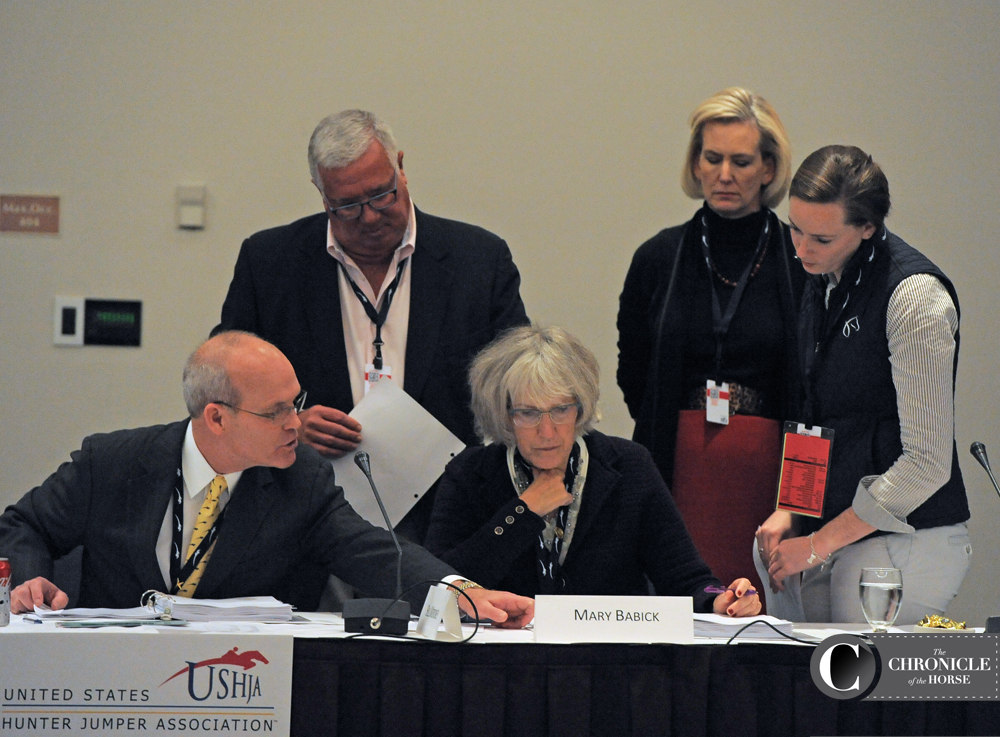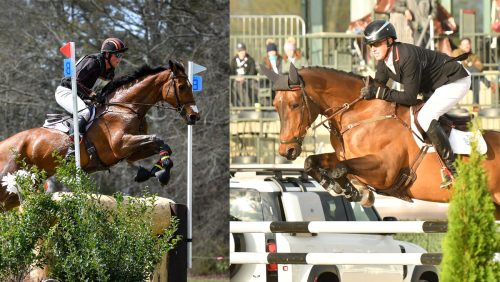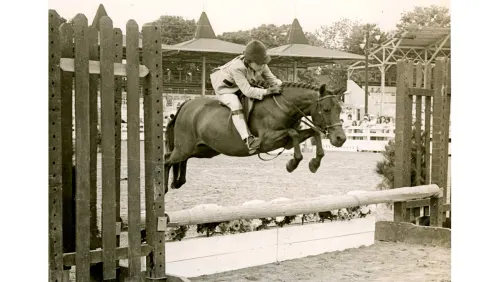Palm Springs, Calif.—Dec. 15
Throughout the 2016 USHJA Annual Meeting, held Dec. 11-15 at the Omni Rancho Las Palmas, one figure that resonated in attendees’ minds: 25 percent.
That figure came from U.S. Equestrian Federation President-Elect Murray Kessler, who gave attendees a sneak peak into his 160-page strategic plan for the direction of the Federation. While the membership has remained steady at 82,000, the annual turnover rate is also steady—at 25 percent.
That inspired discussion on to continuing efforts to clean up the hunter/jumper sport and eliminate poor behavior and horse doping, which—among other things—discourages those new to the sport.
Mary Babick kicked off a presentation titled Integrity In Sport, saying “The key to integrity is consistency of action. As a sport we must stay on course even when there are easier choices.”
She talked about the fledgling anti-doping task force, which she’s getting off the ground along with trainer Tom Brennan, who sits on the Board of Directors and serves on the hunter working group.
“We’re not the Gestapo,” said Brennan. “We’re trying to figure out how we can change the narrative and the semantics that really affect the industry-wide acceptance of what we hear and see. We call things medications that aren’t medications.
“What pressures cause people to cheat?” he continued. “I think blunt conversations about why cheating is so incentivized will be productive, and what we can do to incentivize good behavior.”
USEF CEO and outgoing USHJA president Bill Moroney gave a thorough presentation that outlined the step-by-step process by which the drugs and medications program collects and tests samples, and the next steps taken by the USEF and hearing committee case of a positive result.
Sonja Keating, Senior Vice President and General Counsel for USEF, served as the final presenter, outlining the Safe Sport Initiative, put in place by the U.S. Olympic Committee to ensure fairness, safety and enjoyment for participants of sports that are part of the National Governing Body. Safe Sport addresses six forms of misconduct: sexual misconduct, physical misconduct, emotional misconduct, bullying, hazing and harassment.
While presenters encouraged participants to adopt the mantra of, “if you say something, say something,” audience members chimed in with personal examples of how reporting can be problematic. Several noted that going on a record as a witness on a steward’s report isn’t completely confidential as that report does go to show management. Keating chimed in that infractions may be reported directly to the USEF Regulations Department, and they are best enforced with physical evidence. Moroney encouraged witnesses to pull out their phones and take videos if they see something improper going on.
“The unifying message is that this sport is bigger than individuals. It’s a privilege to be a part of something that brings joy and feeds families, but abuse of that privilege can have extraordinarily negative consequences on the reputation of the sport as a whole,” said Kessler.

ADVERTISEMENT
Incoming USEF president Murray Kessler unveiled part of his 160-page plan for the federation. Photo by Mollie Bailey.
Welfare Conversations Dominate Conversation
Three welfare rules generated plenty of discussion throughout the week, including during today’s final Board of Director’s meeting. The board voted to pass a change to rule GR 843, the so-called “collapse rule,” which specifies that competition management is responsible for ensuring that any horse who collapses is subject to drug testing. Before the change it wasn’t clear who was responsible.
While some show managers feared that the rule was unenforceable, others agreed that competition management would be the most suited to respond in the event of collapse.
Two other welfare rules didn’t fare as well. GR 844 mandates necropsies for all fatalities at a show or fatalities precipitated by an incident at a show, was disapproved.
The USEF averages around 16-18 fatalities across all breeds and disciplines annually at competitions across disciplines, and only those also competing in Fédération Equestre Internationale competition must undergo post mortems.
Moroney stressed out that the board agreed with the intent of the rule, but worried that the wording wasn’t ready for prime time. Brennan pointed out that a horse who sustained a puncture wound in competition and died from infection weeks later would be need a necropsy under this rule. There was also concern about whether the rule applied to horses arriving early to show grounds, or whether it applied to horses on the grounds to be measured or to school and not compete.
The board also voted down a change to GR 839, which sought to strengthen the definition of cruelty and abuse. Board members once again stressed that they agreed completely with the intent of the rule, but its wording would make it difficult, if not impossible, to follow. The rule would require “a hearing before the show committee held in accordance with federation rules,” but many pointed out that most hunter jumper shows don’t have show committees, and in any event there were no guidelines on how to run such a hearing.
These rules, and the others voted on at the USHJA Annual Meeting, still need to be voted on at the USEF Annual Meeting, which takes place Jan. 11-14 in Lexington, Ky., before they are approved

(From left) Outgoing USHJA President and USEF CEO Bill Moroney, USHJA Board Member Bob Bell, incoming USHJA President Mary Babick, USHJA executive operations manager Leslie Mangan and USEF Director of Affiliates Kelsey Shanley conferred before the final Board of Directors Meeting. Photo by Mollie Bailey.
Other Rule Changes Of Note
•Several rule changes created an amateur jumper division with no ownership requirement to be held at three heights: 1.20m to 1.25m, 1.30m to 1.35m and 1.40m to 1.45m with Horse of the Year awards.
•A change to HU 191 passed which will means that horses will no longer get derby credit in green conformation or regular conformation horse of the year standings.
Proponents of the charge argued that derbies shouldn’t count, as they don’t have a conformation component. Board member Shelley Campf disagreed with the proposal, pointing out in smaller areas where the conformation classes were less likely to fill, riders could use derby credit to help their conformation hunters earn points toward qualifying for the fall indoor circuit.
ADVERTISEMENT
•All week, discussion circulated around changes to HU 112, which introduced an option to split USHJA National Hunter Derbies with 40 or more entries into one open section and one section restricted to juniors and amateurs. Some felt this watered down the class, others thought it served the exhibitors well. The newest draft of the rule allows management to chose to offer two derbies: one open and one restricted to juniors and amateurs. A related rule change proposal defined how classes could be split into juniors and amateurs. The adaptations needed a few last-minute tweaks and were referred to the USHJA’s January board meeting.
•Several proposed changes to GR 308 to soften to the so-called “mileage rule” were all voted down. Most felt that as the rule was recently re-written after a vast amount of research it should have time for a test run before it’s changed.
•A proposed change to GR 1306.3 that would have allowed amateurs to act as grooms whose duties included lunging client’s horses without training aids was disapproved. The hunter working group felt the rule was unenforceable, and the amateur committee did not want to allow amateurs to lunge horses for profit.
•Two changes to rules passed which affect the new, and popular, low junior hunter division. One change regards how the classes may be split, and another allows the low junior hunter divisions to run without the standard junior hunter division at zone finals.
•Good news for equitation riders: a change to EQ 112.0 means walk jumps are nixed from the USEF Equitation Tests.
•A change to EQ 105 prohibits bellybands or bandages not on the legs in equitation classes.
•A series of rule changes dictates that the “use of any device with earbud(s) while mounted is prohibited in all schooling areas.” Cell phone use without earbuds is permissible. While all agreed on the rule change, it still needs a few tweaks, so it’s referred to the January board meeting to iron out a few details.
• A change to JP 135.14 passed, addressing how horses may show Hors de Concours—aka unjudged.
With the new rule horses may not show Hors de Concours after they have already shown and been judged in the class. Before, mangers could decide if they would allow horses to show Hors de Concours. Many believed that if a horse misbehaved during a class, it wasn’t usually a good option to immediately go in and school over the course. Others pointed out that rider error may have caused elimination, and the horse “needed a pat and to go around nicely,” as Brennan described.
•A rule change to EQ 110.6 will allow U.S. Pony Medal classes to run with 3-5 exhibitors for half points, matching the Pessoa/US Hunt Seat Medal rule.
•An amendment to HJ 208 passed which increases the requirements for exercising and lunging areas at shows with more than 500 competitors and at most show series.
•A rule was passed to require a steward or certified schooling supervisor for all classes offering $10,000 or more in prize money.
•Sorry long-eared cousins: A rule that would have allowed mules to compete in all non-breed restricted classes failed to pass.
For more on the rule changes, awards, and big conversations at the USHJA Annual Meeting, check out the Jan. 16 issue of the Chronicle of the Horse magazine.















